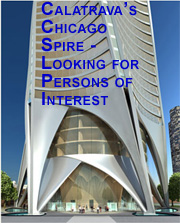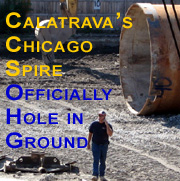
Calatrava's Latest Twist from Spire to Licorice Stick
 |
||||
|
Observations and Images on Architecture, Culture and More, in Chicago and the World. See it all here. |
||||
|
Calatrava's Latest Twist from Spire to Licorice Stick |
||||
|
|
-by Lynn Becker
|
|
|||
|
|
Architect Santiago Calatrava's towering lady is packing on some pounds. Both Crain's Chicago Business and Chicago Tribune architecture critic Blair Kamin have filed reports on this week's announcement of changes to The Chicago (formerly Fordham and AKA Calatrava) Spire, the megaproject taken over earlier this year by Dublin's Shelbourne Development Corporation. What last year was a 124 story building topped by a 400 foot high broadcast antenna is now a 160 story building with no antenna. Where it originally twisted 360 degrees, it will only do a 270 as it makes its way to the top of its 2,000 foot height. According to Kamin, the project's base is now also 35 feet wider. The developer is claiming the Spire would become the world's tallest residential building. With plans for a hotel and retail space dropped (its site at the tip of the Chicago River is too far away from the North Michigan Avenue main drag, says the developers) the proposal has become a pure residential play, with a whopping 3,000,000 square feet of space. Shelbourne's claim to be marketing "exclusive residences" has been diluted by the fact that in place of the original plan of just 300 condos plus a 150 room hotel, the number of units has now almost tripled, to 1,300, making a descent into sales to the general rabble almost inevitable. Perhaps they'll be able to scare up some prospects from among the patron's of neighboring Dick's Last Resort, where, according to Centerstage Chicago, the food is sold in buckets and bra's hang above Other major changes in Shelbourne's revised plan take place at street level where pushing the parking underground has eliminated a five-story annex building in favor of a large plaza that would extend and terminate an existing riverwalk along the north bank of the Chicago River that extends to Michigan Avenue. Shelbourne is also promising that a "spectacular lobby will feature 56-foot tall ceilings and glass walls allowing for an unobstructed view through the base on all sides." In place of a tower that dramatically went from broad to spiky as it rose, the latest incarnation is more like a licorice stick placed on end and stretched thinner at the top. Not that there's anything wrong with that. Many of Chicago's best residential towers, such as Mies van der Rohe's 860-880 Lake Shore Drive, or George Schipporeit's Lake Point Tower don't taper at all, and the lack of setbacks doesn't seem to hurt the quality of their appearance one bit. When you start pushing half a mile, however, to the conventional eye there appears a bit too much bulk at the top, as if it were a block of marble left unsculpted at its crest. Like Donald Trump, Shelbourne does it because it can. The zoning laws that created the setbacks in the Art Deco skyscrapers of the 1920's are long gone, and the game now is all about maximizing floorplates, especially on those premium-priced upper floors. Will the tower wind up becoming a Spire Too Far? On its web site Shelbourne boasts of developing 1,500,000 square feet of space in Ireland, and of having $2,000,000,000 worth of projects currently in the pipeline. Just by itself, however, the Chicago Spire would double that square footage, and while no new cost estimate has been released for the revised project, it could eventually edge up to challenge that $2 billion total. Are there really another 1,000 deca-millionares or better still looking for these kind of units, who haven't already been snapped up by Trump (700+ units), the carriage-courted Elysian (300+ units) or the other top-of-the-price-point projects already completed or under construction? Shelbourne must get the city's approval for their revised plan, as well as mollify neighborhood activists, but it still claims it will break ground in the spring of next year. If the Spire makes it to the finish line, however, it will become as iconic a symbol of Chicago architecture as Bertrand Goldberg's Marina City. It will also serve as beauty to the beast of another 2,000 foot-high project that the elimination of Calatrava's antenna spire threatens to bring back from the dead. The Tribune is reporting that developer Paul Beitler is working to resurrect his noxious proposal to construct a 2,000 foot high television tower, this time at a 50,000 square foot site on which he's just acquired a 99 year ground lease, just two blocks west of the location of Calatrava's spire. The original design by architect Cesar Pelli is a monstrous concrete tripod that would slum up the city's skyline, mocking the elegance of the Calatrava Spire like a Quasimodo standing behind Helen of Troy and making rude faces.
Join a discussion on this story.
© Copyright 2006 images and text Lynn Becker All rights reserved.
|
 
   |
|||